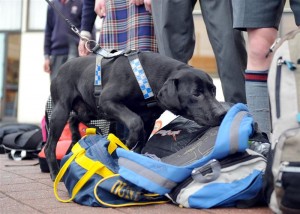Without a doubt it is challenging to protect and serve our community. I write a lot on this blog about the shortcomings and limitations in forensic science today. Be assured that there is a lot of good science in forensic science.
No matter how far we come, in some arenas the persistence of the myth of validity permeates. One such area is the continued use of canines at roadside. Canines are used at roadside to try to develop probable cause to search a vehicle or used at other places to try to detect illicit drugs or explosives.

In one recent CNN news article Truck suspected to hold explosives found full of energy drinks the following is documented:
A police dog’s false hit for explosives on a truck that had been driven erratically by a man who did not speak English attracted a throng of law enforcement personnel to a rural road in Wisconsin… But they turned up nothing more powerful than energy drinks
But this is not unique. In fact 60 minutes did a full segment on this topic in 2004: Does The Nose Know? Some Drug And Bomb-Sniffing Dogs Are Unreliable. Within the story it remarks on the Russell Lee Ebersole affair where he was convicted on 25 counts of fraud after providing the State Department, the IRS and the Federal Reserve with bomb-sniffing dogs that, when given a test, couldn’t detect 50 pounds of dynamite or 15 pounds of C-4 plastic explosives.
Auburn University professor Larry Myers, one of the country’s leading experts on canine detection programs in that program summed it up well when he said:
They can tell you that something’s there, that’s not there, simply to get praise, to get food, to get whatever they’re working for. It is a tremendous problem. We have trainers that can’t train. Dogs are being used that can’t –don’t know how to do anything.
The warrantless non-consensual intrusion into the property of another by the government without probable cause should not be excused by a doggie sniff. It just is not right.
Each dog is unique. No dog has been truly scientifically validated in terms of its purported sensitivities or selectiveness. While it is perhaps impossible to do so, it does not mean that we should accept that the dog is selective, specific sensitive and its results valid and true.
Some of the frequent problems surround the issue of cuing the dog. Dogs, like humans, are masters of body language. Even well-trained dogs have a particular susceptibility to pick up even subconscious cues from their handlers. This is why there is a need to not leash-lead the dog. Also the handler should also wear sunglasses.
It is important to remember that there are basically two types of trained dogs: active alert and passive alert. It is important to know the limitations on both. It is also important to note that dogs are not robots. They have feelings, wants and desires. They want to feel special. They want to be rewarded. Sometimes they will alert even against their training in order to get the reward. Sometimes, they will alert simply to stop having to work due to their environment, such as it is too hot or the dog is tired.
In addition, most dogs are not distraction trained. At roadside or in the field there is a lot of distractions that can overwhelm even a well-0trianed dog and lead that dog to alert so it can be removed from the overload of the environmental stimuli.
It is critical for the Practitioner to get the dog’s alert record, which should be kept by the handler. This record can provide a meaningful source of cross-examination in terms of applying statistics such as likelihood ratios and percent false positives.
It is most important to remember that doggie sniffs are not validated science.


